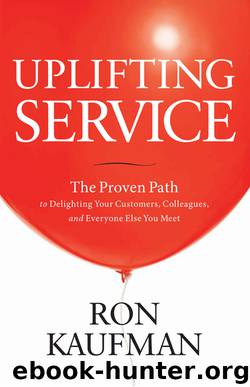Uplifting Service by Ron Kaufman

Author:Ron Kaufman
Language: eng
Format: epub
ISBN: 9780984762552
Publisher: Evolve Publishing
What Is a Successful Service Improvement Process?
A Service Improvement Process creates focus. It keeps the spotlight on service improvement and builds passion for elevating service. This is not a onetime thing that people may or may not notice. It’s a continuous progression of issues, questions, projects, and invitations connecting people with your vision and committing them to service improvement.
This building block drives service innovation. It’s the crucible in which competition powers creativity and stubborn problems meet out-of-the-box solutions. This is where customer complaints are wanted and welcome, where survey reports are carefully examined for new ideas and insights.
Service leaders know that competitors are always snapping at their heels or already stepping out ahead. To gain a sustainable advantage, you must deliver more value today than you did yesterday, and even more tomorrow. A Service Improvement Process keeps focus and attention on this goal.
A Service Improvement Process creates synergy by connecting people between levels and functions. Some issues require ownership on the front line, involvement from the middle, and sponsorship from above. Other service issues are quickly solved by teams working across silos. Cross-functional team members bring new perspectives and fresh energy to old problems.
A well-designed Service Improvement Process promotes communication across functions, divisions, and departments. It stimulates collaboration across levels, languages, and locations. With thoughtful planning and invitations, you can also tap the creative energy of your customers, vendors, distributors, and even your government or industry regulators.
Your Service Improvement Process may include many different methods. You can use the following approaches, create new ones, combine old ones, and change any you are using over time. Your constant challenges are to focus attention, gain active participation, and generate real results.
Problem-solving workshops: Albert Einstein said, “Problems cannot be solved by the same level of thinking that created them.” Elevating an issue from daily difficulty to a dedicated workshop also graduates that problem—and the people working on it—to a higher level of thinking.
Cross-functional teams: Sometimes the best ideas come from those who aren’t closest to the problems. The participants on cross-functional teams not only learn to understand the concerns of other departments, but they also bring fresh energy and perspectives.
Job rotations: Do you know what it’s like to wear someone else’s shoes for a day? Try it, and let your employees try it, too. The first question from people reporting to new departments is typically, “Why do you do it this way?” And that’s often followed by, “Wouldn’t it work better if … ?”
Service improvement contests: Many people are motivated by a challenge to win. If your team responds to competition, create a structure that harnesses this drive for the benefit of those you serve. When service improves for customers on the outside and for colleagues on the inside, then people serving on all sides will feel like winners.
Sharing best practices: Sharing effective examples and successful stories can educate, motivate, and inspire. Find out what is working well inside your organization and then spread the news with online stories, brown bag lunches, weekly meetings, town hall events, formal case studies, and personal interviews and conversations.
Download
This site does not store any files on its server. We only index and link to content provided by other sites. Please contact the content providers to delete copyright contents if any and email us, we'll remove relevant links or contents immediately.
Bad Blood by John Carreyrou(6581)
Rich Dad Poor Dad by Robert T. Kiyosaki(6513)
Principles: Life and Work by Ray Dalio(6296)
Playing to Win_ How Strategy Really Works by A.G. Lafley & Roger L. Martin(6083)
Management Strategies for the Cloud Revolution: How Cloud Computing Is Transforming Business and Why You Can't Afford to Be Left Behind by Charles Babcock(4546)
The Confidence Code by Katty Kay(4220)
Thinking in Bets by Annie Duke(4184)
American Kingpin by Nick Bilton(3818)
Delivering Happiness by Tony Hsieh(3395)
Project Animal Farm: An Accidental Journey into the Secret World of Farming and the Truth About Our Food by Sonia Faruqi(3189)
The Power of Habit by Charles Duhigg(3093)
The Tyranny of Metrics by Jerry Z. Muller(3028)
Brotopia by Emily Chang(3026)
Mastering Bitcoin: Programming the Open Blockchain by Andreas M. Antonopoulos(3010)
The Marketing Plan Handbook: Develop Big-Picture Marketing Plans for Pennies on the Dollar by Robert W. Bly(3006)
I Live in the Future & Here's How It Works by Nick Bilton(2960)
The Content Trap by Bharat Anand(2887)
Applied Empathy by Michael Ventura(2864)
Building a StoryBrand by Donald Miller(2862)
